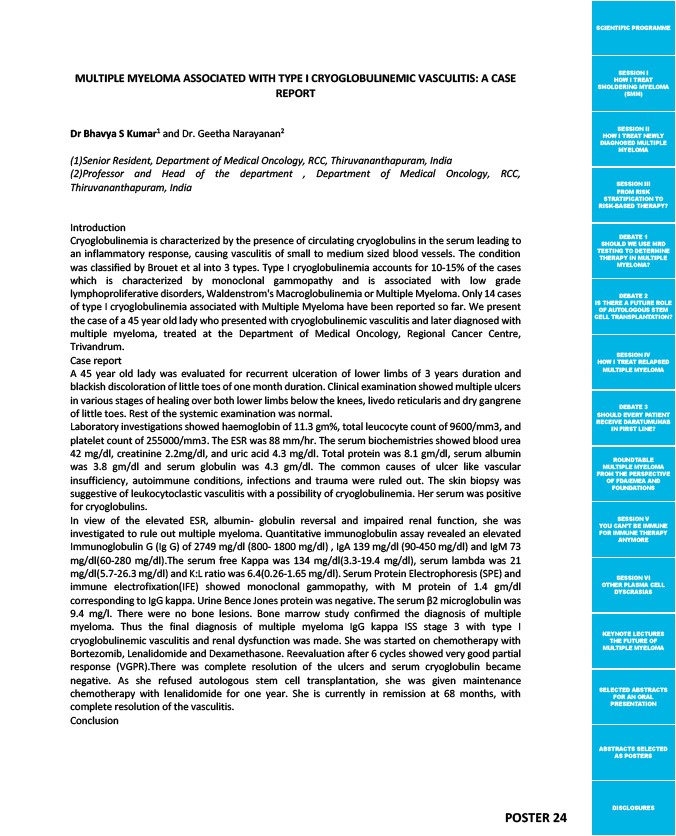
SCIENTIFIC PROGRAMME
SESSION I
HOW I TREAT
SMOLDERING MYELOMA
(SMM)
SESSION II
HOW I TREAT NEWLY
DIAGNOSED MULTIPLE
MYELOMA
SESSION III
FROM RISK
STRATIFICATION TO
RISK-BASED THERAPY?
DEBATE 1
SHOULD WE USE MRD
TESTING TO DETERMINE
THERAPY IN MULTIPLE
MYELOMA?
DEBATE 2
IS THERE A FUTURE ROLE
OF AUTOLOGOUS STEM
CELL TRANSPLANTATION?
SESSION IV
HOW I TREAT RELAPSED
MULTIPLE MYELOMA
DEBATE 3
SHOULD EVERY PATIENT
RECEIVE DARATUMUMAB
IN FIRST LINE?
ROUNDTABLE
MULTIPLE MYELOMA
FROM THE PERSPECTIVE
OF FDA/EMEA AND
FOUNDATIONS
SESSION V
YOU CAN’T BE IMMUNE
FOR IMMUNE THERAPY
ANYMORE
SESSION VI
OTHER PLASMA CELL
DYSCRASIAS
KEYNOTE LECTURES
THE FUTURE OF
MULTIPLE MYELOMA
SELECTED ABSTRACTS
FOR AN ORAL
PRESENTATION
ABSTRACTS SELECTED
AS POSTERS
MULTIPLE MYELOMA ASSOCIATED WITH TYPE I CRYOGLOBULINEMIC VASCULITIS: A CASE
DISCLOSURES POSTER 24
REPORT
Dr Bhavya S Kumar1 and Dr. Geetha Narayanan2
(1)Senior Resident, Department of Medical Oncology, RCC, Thiruvananthapuram, India
(2)Professor and Head of the department , Department of Medical Oncology, RCC,
Thiruvananthapuram, India
Introduction
Cryoglobulinemia is characterized by the presence of circulating cryoglobulins in the serum leading to
an inflammatory response, causing vasculitis of small to medium sized blood vessels. The condition
was classified by Brouet et al into 3 types. Type I cryoglobulinemia accounts for 10-15% of the cases
which is characterized by monoclonal gammopathy and is associated with low grade
lymphoproliferative disorders, Waldenstrom's Macroglobulinemia or Multiple Myeloma. Only 14 cases
of type I cryoglobulinemia associated with Multiple Myeloma have been reported so far. We present
the case of a 45 year old lady who presented with cryoglobulinemic vasculitis and later diagnosed with
multiple myeloma, treated at the Department of Medical Oncology, Regional Cancer Centre,
Trivandrum.
Case report
A 45 year old lady was evaluated for recurrent ulceration of lower limbs of 3 years duration and
blackish discoloration of little toes of one month duration. Clinical examination showed multiple ulcers
in various stages of healing over both lower limbs below the knees, livedo reticularis and dry gangrene
of little toes. Rest of the systemic examination was normal.
Laboratory investigations showed haemoglobin of 11.3 gm%, total leucocyte count of 9600/mm3, and
platelet count of 255000/mm3. The ESR was 88 mm/hr. The serum biochemistries showed blood urea
42 mg/dl, creatinine 2.2mg/dl, and uric acid 4.3 mg/dl. Total protein was 8.1 gm/dl, serum albumin
was 3.8 gm/dl and serum globulin was 4.3 gm/dl. The common causes of ulcer like vascular
insufficiency, autoimmune conditions, infections and trauma were ruled out. The skin biopsy was
suggestive of leukocytoclastic vasculitis with a possibility of cryoglobulinemia. Her serum was positive
for cryoglobulins.
In view of the elevated ESR, albumin- globulin reversal and impaired renal function, she was
investigated to rule out multiple myeloma. Quantitative immunoglobulin assay revealed an elevated
Immunoglobulin G (Ig G) of 2749 mg/dl (800- 1800 mg/dl) , IgA 139 mg/dl (90-450 mg/dl) and IgM 73
mg/dl(60-280 mg/dl).The serum free Kappa was 134 mg/dl(3.3-19.4 mg/dl), serum lambda was 21
mg/dl(5.7-26.3 mg/dl) and K:L ratio was 6.4(0.26-1.65 mg/dl). Serum Protein Electrophoresis (SPE) and
immune electrofixation(IFE) showed monoclonal gammopathy, with M protein of 1.4 gm/dl
corresponding to IgG kappa. Urine Bence Jones protein was negative. The serum β2 microglobulin was
9.4 mg/l. There were no bone lesions. Bone marrow study confirmed the diagnosis of multiple
myeloma. Thus the final diagnosis of multiple myeloma IgG kappa ISS stage 3 with type I
cryoglobulinemic vasculitis and renal dysfunction was made. She was started on chemotherapy with
Bortezomib, Lenalidomide and Dexamethasone. Reevaluation after 6 cycles showed very good partial
response (VGPR).There was complete resolution of the ulcers and serum cryoglobulin became
negative. As she refused autologous stem cell transplantation, she was given maintenance
chemotherapy with lenalidomide for one year. She is currently in remission at 68 months, with
complete resolution of the vasculitis.
Conclusion